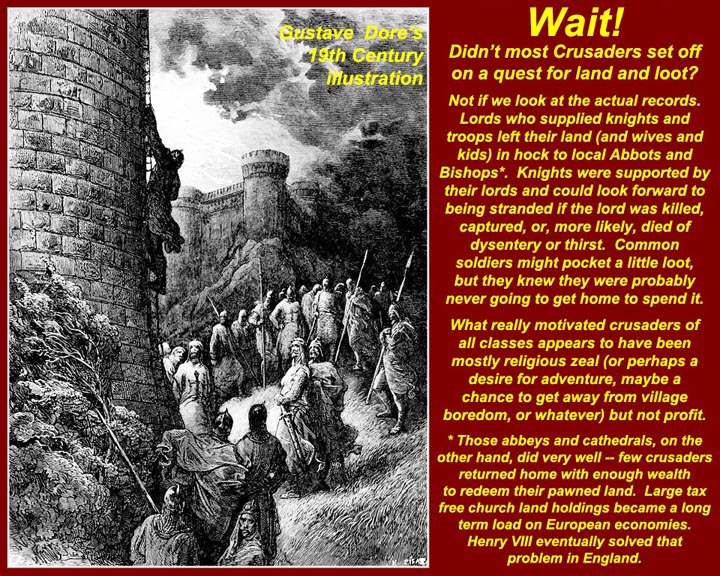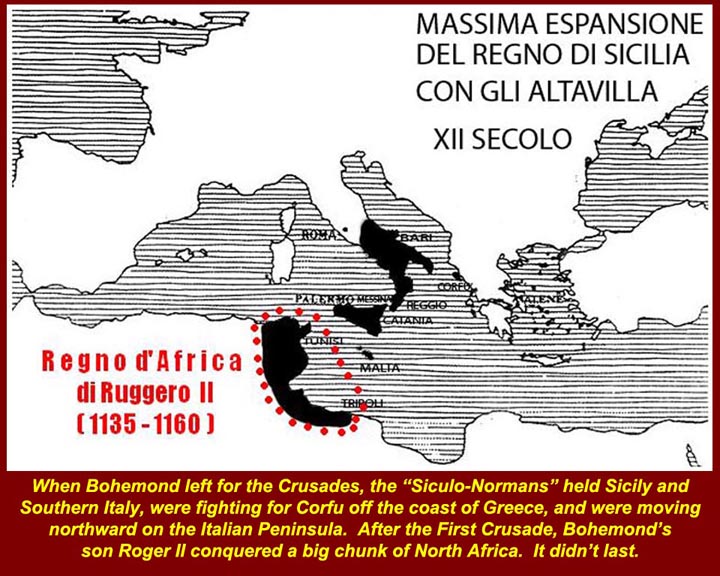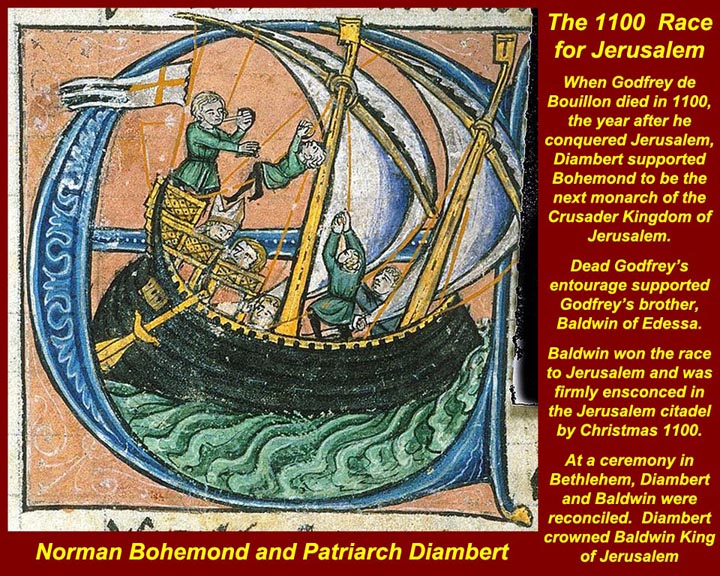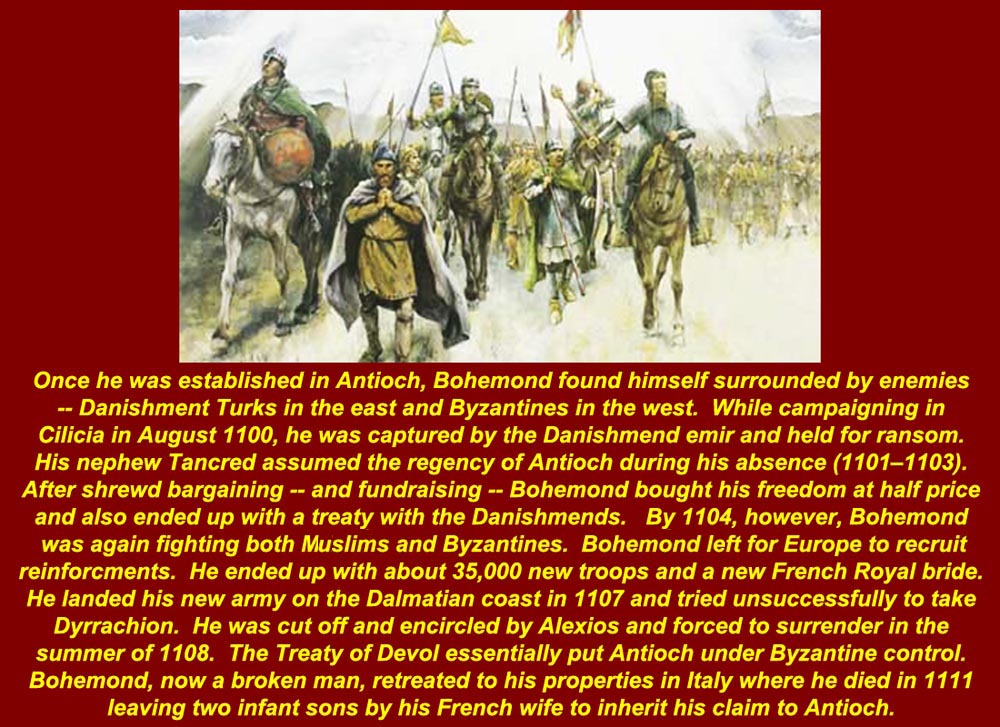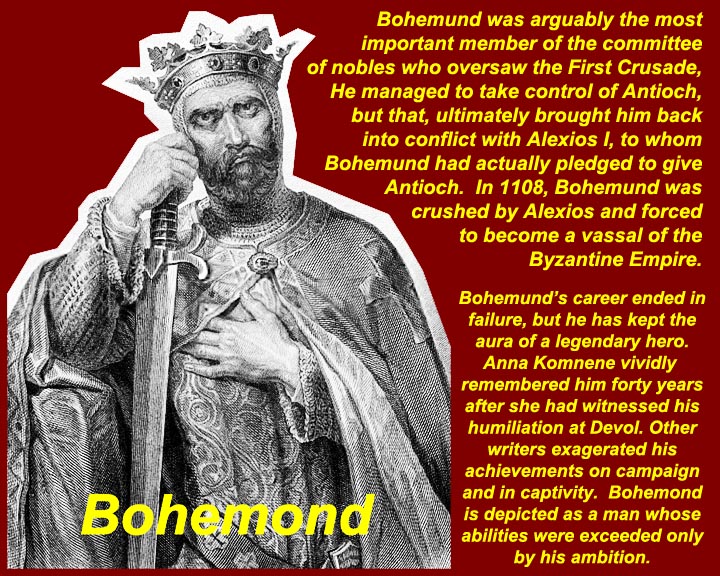After hundreds of years of Muslim incursions into formerly Christian territories, the West was finally aroused to resist. Kings, nobles, prelates, priests, monks, and commoners were almost always motivated by religious belief and zeal (albeit, perhaps mixed with more than a little bit of escapism and greed and self interest). But who were the motivators? Ultimately it may have been the Turkic leaders who were expanding Islamic suzerainty, but that alone didn't move anyone into action until besieged Byzantine emperors and somewhat threatened Catholic popes (the latter often working through charismatic preachers) got into the act.
This unit will look at the more important folks involved in the first four crusades along with a few maps and illustrations to show where they were active..
First Crusade -- 1096-1099:
Despite the organizational and logistics problems involved, the First Crusade succeeded -- but only because of disunity among its enemies.
Summaries:
http://en.wikipedia.org/wiki/First_Crusade
https://www.worldhistory.org/First_Crusade/
https://www.britannica.com/event/Crusades/The-First-Crusade-and-the-establishment-of-the-Latin-states
https://en.wikipedia.org/wiki/Crusades
Chronology - First Crusade 1095 - 1100
Launched by Pope Urban II at the Council of Clermont in 1095, the First Crusade was the most successful. Urban gave a dramatic speech urging Christians to swarm towards Jerusalem and make it safe for Christian pilgrims by taking it away from the Muslims. The armies of the First Crusade left in 1096 and captured Jerusalem in 1099. From these conquered lands Crusaders carved out small kingdoms for themselves which endured for some time, though not long enough to have a real impact upon local culture.November 18, 1095 Pope Urban II opens the Council of Clermont where ambassadors from the Byzantine emperor Alexius I Comnenus, asking help against the Muslims, were warmly received.
November 27, 1095 Pope Urban II calls for a Crusade (in Arabic: al-Hurub al-Salibiyya, "Wars of the Cross") in a famous speech at the Council of Clermont. Although his actual words have been lost, tradition has it that he was so persuasive that the crowd shouted out in response "Deus vult! Deus vult!" ("God wills it"). Urban had earlier arranged that Raymond, Count of Toulouse (also of St. Giles), would volunteer to take up the cross then and there and offered other participants two important concession: protection for their estates at home while they were gone and plenary indulgence for their sins. The inducements for other Europeans were just as great: serfs were allowed the leave the land they were bound to, citizens were free from taxation, debtors were given a moratorium on interest, prisoners were released, death sentences were commuted, and much more.---------------------------------------------------------------------------------
December 1095 Adhemar de Monteil (also: Adémar, Aimar, or Aelarz), Bishop of Le Puy, is chosen by Pope Urban II as the Papal Legate for the First Crusade. Although various secular leaders would argue amongst themselves over who led the Crusade, the pope always regards Adhemar as its true leader, reflecting the primacy of spiritual over political goals.
April 1096 The first of the four planned Crusader armies arrives in Constantinople, at that time ruled by Alexius I Comnenus.
April 20, 1096 Peter the Hermit, a native of Amiens in France, leads 20,000 commoners out of Cologne on the Peasants' Crusade.
May 06, 1096 Rhineland Massacres: Crusaders moving through the Rhine Valley massacre Jews in Speyer. This is the first major slaughter of a Jewish community by Crusaders marching to the Holy Land.
May 18, 1096 Crusaders massacre Jews in Worms, Germany. The Jews in Worms had heard about the massacre in Speyer and try to hide - some in their homes and some even in the bishop's palace, but they are unsuccessful.
May 27, 1096 Crusaders massacre Jews in Mainz, Germany. The bishop hides over 1,000 in his cellars but the Crusaders learn of this and kill most of them. Men, women, and children of all ages are slaughtered indiscriminately.
May 30, 1096 Crusaders attack Jews in Cologne, Germany, but most are protected by local citizens who hide the Jews in their own houses. Archbishop Hermann would later send them to safety in neighboring villages, but the Crusaders would follow and slaughter hundreds.
June 1096 Crusaders led by Peter the Hermit sack Semin and Belgrade, forcing Byzantine troops to flee to Nish.
July 03, 1096 Peter the Hermit's Peasants' Crusade meets Byzantine forces at Nish. Although Peter is victorious and moves towards Constantinople, about a quarter of his forces are lost.
July 12, 1096 Crusaders under the leadership of Peter the Hermit reach Sofia, Hungary.
August 1096 Godfrey De Bouillon, the Margrave of Antwerp and a direct descendant of Charlemagne, sets off to join the First Crusade at the head of an army of at least 40,000 soldiers. Godfrey is the brother of Baldwin of Boulogne (the future Baldwin I of Jerusalem..
August 01, 1096 The Peasants' Crusade, which had departed from Europe that Spring, is shipped over the Bosprous by Emperor Alexius I Comnenus of Constantinople. Alexius I had welcomed these first Crusaders, but they are so decimated by hunger and disease that they cause a great deal of trouble, looting churches and houses around Constantinople. Thus, Alexius has them taken to Anatolia as quickly as possible. Made up of poorly organized groups led by Peter the Hermit and Walter the Pennyless (Gautier sans-Avoir, who had led a separate contingent from Peter, most of whom were killed by the Bulgarians), the Peasants' Crusade would proceed to pillage Asia Minor but meet with a very messy end.
September 1096 A group from the Peasants' Crusade is besieged at Xerigordon and forced to surrender. Everyone is given a choice of beheading or conversion. Those who convert in order to avoid beheading are sent into slavery and never heard from again.
October 1096 Bohemond I (Bohemond Of Otranto, French Bohémond De Tarente), prince of Otranto (1089–1111) and one of the leaders of the First Crusade, leads his troops across the Adriatic Sea. Bohemond would be largely responsible for the capture of Antioch and he was able to secure the title Prince of Antioch (1098–1101, 1103–04).
October 1096 The Peasants' Crusade is massacred at Civeot, Anatolia, by Turkish archers from Nicaea. Only small children are spared the sword so that they could be sent into slavery. Around 3,000 manage to escape back to Constantinople where Peter the Hermit had been in negotiations with Emperor Alexius I Comnenus.
October 1096 Raymond, Count of Toulouse (also of St. Giles), leaves for the Crusade in the company of Adhemar, the bishop of Puy and Papal Legate.
December 1096 The last of the four planned Crusader armies arrives at Constantinople, bringing the total numbers to approximately 50,000 knights and 500,000 footmen. Curiously there isn't a single king among the Crusade leaders, a sharp difference from later Crusades. At this time Philip I of France, William II of England, and Henry IV of Germany are all under excommunication by Pope Urban II.
December 25, 1096 Godfrey De Bouillon, the Margrave of Antwerp and a direct descendant of Charlemagne, arrives in Constantinople. Godfrey would be the primary leader of the First Crusade, thus making it a largely French war in practice and causing the inhabitants of the Holy Land to refer to Europeans generally as "Franks."
January 1097 Normans led by Bohemond I destroy a village on the way to Constantinople because it is inhabited by heretic Paulicians.
March 1097 After relations between Byzantine leaders and the European Crusaders deteriorates, Godfrey De Bouillon leads an attack on the Byzantine Imperial Palace at Blachernae.
April 26, 1097 Bohemond I joins his Crusading forces with the Lorrainers under Godfrey De Bouillon. Bohemond is not especially welcome in Constantinople because his father, Robert Guiscard, had invaded the Byzantine Empire and captured the cities of Dyrrhachium and Corfu. ("Guiscard" is most properly translated as (Wise Guy".)
May 1097 With the arrival of Duke Robert of Normandy, all of the major participants of the Crusades are together and the large force crosses into Asia Minor. Peter the Hermit and his few remaining followers join them. How many were there? Estimates vary wildly: 600,000 according to Fulcher of Chartres, 300,000 according to Ekkehard, and 100,000 according to Raymond of Aguilers. Modern scholars place their numbers at around 7,000 knights and 60,000 infantry.
May 21, 1097 Crusaders begin the siege of Nicaea, a mostly Christian city guarded by several thousand Turkish troops. Byzantine Emperor Alexius I Comnenus has a strong interest in the capture of this heavily fortified city because it lies just 50 miles from Constantinople itself. Nicaea is at this time under the control of Kilij Arslan (Dawud Kılıj Arslan ibn Süleyman ibn Kut al-Mish), sultan of the Seljuk Turkish state of Rhüm (a reference to Rome). Unfortunately for him Arslan and the bulk of his military forces are at war with a neighboring Emir when the crusaders arrive; although he quickly makes peace in order to lift the siege, he would be unable to arrive in time.
June 19, 1097 Crusaders captured Antioch after a long siege. This had delayed progress towards Jerusalem by a year.
June 19, 1097 The city of Nicaea surrenders to the Crusaders. Emperor Alexius I Comnenus of Constantinople makes a deal with the Turks that puts the city in his hands and kicks the Crusaders out. In not allowing them to pillage Nicaea, Emperor Alexius engenders a great deal of animosity towards the Byzantine Empire.
July 01, 1097 Battle of Dorylaeum: While travelling from Nicaea to Antioch, the Crusaders split their forces into two groups and Kilij Arslan seizes the opportunity to ambush some of them near Dorylaeum. In what would become known as the Battle of Dorylaeum, Bohemond I is saved by Raymond of Toulouse. This could have been a disaster for the Crusaders, but the victory frees them of both supply problems and from harassment by Turks for a while.
August 1097 Godfrey of Bouillon temporarily occupies the Seljuk city of Iconium (Konya).
September 10, 1097 Splitting off from the main Crusading force, Tancred of Hauteville captures Tarsus. Tancred is a grandson of Robert Guiscard and nephew of Bohemund of Taranto.
October 20, 1097 The first Crusaders arrived at Antioch
October 21, 1097 The Crusaders' siege of the strategically important city of Antioch begins. Located in the mountainous region of Orontes, Antioch had never been captured by any means other than treachery and is so large that the Crusader army is unable to completely surround it. During this siege Crusaders learn to chew on the reeds known to Arabs as sukkar - this is their first experience with sugar and they come to like it.
December 21, 1097 First Battle of Harenc: Because of the size of their forces, Crusaders besieging Antioch are constantly running short of food and conduct raids into the neighboring regions despite the risk of Turkish ambushes. One of the largest of these raids consists of a force of 20,000 men under the command of Bohemond and Robert of Flanders. At this same time, Duqaq of Damascus had been approaching Antioch with a large relief army. Robert is quickly surrounded, but Bohemond comes up quickly and relieves Robert. There are heavy casualties on both sides and Duqaq is forced to withdraw, abandoning his plan to relieve Antioch.
February 1098 Tancred and his forces rejoin the main body of Crusaders, only to find Peter the Hermit attempting to flee to Constantinople. Tancred makes sure that Peter returns to continue the fight.
February 09, 1098 Second Battle of Harenc: Ridwan of Aleppo, titular ruler of Antioch, raises an army to relieve the besieged city of Antioch. The Crusaders learn of his plans and launch a preemptive assault with their remaining 700 heavy cavalry. The Turks are forced into retreat to Aleppo, a city in northern Syria, and the plan to relieve Antioch is abandoned.
March 10, 1098 Christian citizens of Edessa, a powerful Armenian kingdom that controls a region from the coastal plain of Cilicia all the way to the Euphrates, surrenders to Baldwin of Boulogne. Possession of this region would provide a secure flank to the Crusaders.
June 01, 1098 Stephen of Blois takes a large contingent of Franks and abandons the siege of Antioch after he hears that Emir Kerboga of Mosul with an army of 75,000 is drawing near to relieve the besieged city.
June 03, 1098 The Crusaders under the command of Bohemond I capture Antioch, despite their numbers having been depleted by numerous defections during the previous months. The reason is treachery: Bohemond conspires with Firouz, an Aremenian convert to Islam and captain of the guard, to allow the Crusaders access to the Tower of the Two Sisters. Bohemond is named Prince of Antioch.
June 05, 1098 Emir Kerboga, Attabeg of Mosul, finally arrives at Antioch with an army of 75,000 men and lays siege to the Christians who had just captured the city themselves (although they do not have full control of it - there are still defenders barricaded in the citadel). In fact, the positions which they had occupied a couple of days before are now occupied by the Turkish forces. A relief army commanded by the Byzantine Emperor turns back after Stephen of Blois convinces them that the situation in Antioch is hopeless. For this, Alexius is never forgiven by the Crusaders and many would claim that Alexius' failure to help them released them from their vows of fealty to him.
June 10, 1098 Peter Bartholomew, a servant of a member of Count Raymond's army, experiences a vision of the Holy Lance being located at Antioch. Also known as the Spear of Destiny or the Spear of Longinus, this artifact is alleged to be the spear that pierced the side of Jesus Christ when he was on the cross.
June 14, 1098 The Holy Lance is "discovered" by Peter Bartholomew subsequent to a vision from Jesus Christ and St. Andrew that it is located in Antioch, recently captured by the Crusaders. This dramatically improves the spirits of the Crusaders now besieged in Antioch by Emir Kerboga, Attabeg of Mosul.
June 28, 1098 Battle of Orontes: Following the Holy Lance "discovery" in Antioch, the Crusaders drive back a Turkish army under the command of Emir Kerboga, Attabeg of Mosul, sent to recapture the city. This battle is generally regarded as having been decided by morale because the Muslim army, split by internal dissent, numbers 75,000 strong but is defeated by a mere 15,000 tired and poorly equipped Crusaders.
August 01, 1098 Adhemar, Bishop of Le Puy and nominal leader of the First Crusade, dies during an epidemic. With this, Rome's direct control over the Crusade effectively ends.
December 11, 1098 Crusaders capture the city of M'arrat-an-Numan, a small city east of Antioch. According to reports, Crusaders are observed eating the flesh of both adults and children; as a consequence, the Franks would be labeled "cannibals" by Turkish historians.
January 13, 1099 Raymond of Toulouse leads the first contingents of Crusaders away from Antioch and towards Jerusalem. Bohemund disagrees with Raymond's plans and remains in Antioch with his own forces.
February, 1099 Raymond of Toulouse captures the Krak des Chevaliers, but he is forced to abandon it in order to continue his march to Jerusalem.
February 14, 1099 Raymond of Toulouse begins a siege of Arqah, but he would be forced to give up in April.
April 08, 1099 Long criticized by doubters that he had truly found the Holy Lance, Peter Bartholomew agrees to the suggestion of priest Arnulf Malecorne that he undergo a trial by fire in order to prove the relic's authenticity. He dies of his injuries on April 20, but because he does not die immediately Malecorne declares the trial a success and the Lance genuine.
June 06, 1099 Citizens of Bethlehem plead with Tancred of Bouillon (nephew of Bohemond) to protect them from the approaching Crusaders who had by this time acquired a reputation for vicious looting of cities they capture.
June 07, 1099 The Crusaders reach the gates of Jerusalem. then controlled by governor Iftikhar ad-Daula. Although the Crusaders had originally marched out of Europe to take Jerusalem back from the Turks, the Fatimids had already expelled the Turks the year before. The Fatimid caliph offers the Crusaders a generous peace agreement that includes protection of Christian pilgrims and worshippers in the city, but the Crusaders are uninterested in anything less than full control of the Holy City - nothing short of unconditional surrender would satisfy them.
July 08, 1099 The Crusaders attempt to take Jerusalem by storm but fail. According to reports, they originally attempt to march around the walls under the leadership of priests in the hope that the walls would simply crumble, as did the walls of Jericho in biblical stories. When that fails, unorganized attacks are launched with no effect.
July 10, 1099 Death of Ruy Diaz de Vivar, known as El Cid (= Siidi = Arabic for "lord").
July 13, 1099 Armies of the first Crusade launch a final assault on Muslims in Jerusalem.
July 15, 1099 Crusaders breach the walls of Jerusalem at two points: Godfrey of Bouillon and his brother Baldwin at St. Stephen's Gate on the north wall and Count Raymond at the Jaffa Gate on the west wall, thus allowing them to capture the city. Estimates place the number of casualties as high as 100,000. Tancred of Hauteville, a grandson of Robert Guiscard and nephew of Bohemund of Taranto, is the first Crusader through the walls. The day is Friday, Dies Veneris, the anniversary of when Christians believe that Jesus redeemed the world and is the first of two days of unprecedented slaughter.
July 16, 1099 Crusaders herd Jews of Jerusalem into a synagogue and set it on fire.
July 22, 1099 Raymond IV of Toulouse is offered the title King of Jerusalem but he turns it down and leaves the region. Godfrey De Bouillon is offered the same title and turns it down as well, but is willing to be named Advocatus Sancti Seplchri (Advocate of the Holy Sepulcher), the first Latin ruler of Jerusalem. This kingdom would endure in one form or another for several hundred years but it would always be in a precarious position. It is based upon a long, narrow strip of land with no natural barriers and whose population is never entirely conquered. Continual reinforcements from Europe are required but not always forthcoming.
July 29, 1099 Pope Urban II dies. Urban had followed the lead set by his predecessor, Gregory VII, by working to enhance the power of the papacy against the power of secular rulers. He also became known for having initiated the first of the Crusades against Muslim powers in the Middle East. Urban dies, though, without ever learning that the First Crusade had taken Jerusalem and was a success. (Urban II was succeeded by Pascal II, who had to contend with three successive anti-popes.)
August 1099 Records indicate that Peter the Hermit, principal leader of the failed Peasants' Crusade, serves as leader of the supplicatory processions in Jerusalem which occur prior to the battle of Ascalon.
August 12, 1099 Battle of Ascalon: Crusaders successfully fight off an Egyptian army sent to relieve Jerusalem. Prior to its capture by the Crusaders, Jerusalem had been under the control of the Fatamid Caliphate of Egypt, and the vizier of Egypt, al-Afdal, raises an army of 50,000 men that outnumber the remaining Crusaders five to one, but which is inferior in quality. This is the final battle in the First Crusade.
September 13, 1099 Crusaders set fire to Mara, Syria.
First Crusade Aftermath 1100 - 1143
1100 Islamic rule is weakened because of power struggles among Islamic leaders and the Christian crusades.
1100 Bohemund of Taranto is captured by the Seljuks. His nephew, Tancred of Hauteville, becomes regent of Antioch.
1100 With the support of Pisan merchants, Daimbert (aka Dagobert), the Archbishop of Pisa forces Godfrey of Bouillon to dismiss Arnulf and make Daimbert himself the first official Patriarch of Jerusalem.
1100 Byzantine emperor Alexius I Comnenus launches new attacks on the Seljuk Turks.
June 1100 Godfrey De Bouillon attempts to negotiate a deal with the Venetians: they could take a third of any city they help capture plus trading rights throughout the Kingdom of Jerusalem if they support him against his political rivals.
July 18, 1100 Godfrey De Bouillon dies while attempting to conquer Egypt.
December 11, 1100 Baldwin of Boulogne (also Baldwin of Edessa) is crowned King of Jerusalem (Baldwin I). The position is grander in name than in practice. The "kingdom" is divided into four feudal principalities over which Baldwin has limited control. His power is further checked by an ecclesiastical hierarchy which is subject only to the pope in Rome. Finally, several port cities are controlled by Italian city-states like Venice and Genoa as the price for the naval aid and sea trade upon which the Latin Kingdom depends for survival.
December 25, 1100 Baldwin I is actually crowned King of Jerusalem on Christmas Day.
1101 Raymond IV of Toulouse, count of Tripoli, captures Ankara from the Seljuk Turks.
March 1101 Milan archbishop Anselm of Buis and Count Albert of Biandrate arrive at Constantinople with a Lombard army in order to launch attacks on Muslims in the Holy Land.
April 1101 Baldwin I negotiates a deal with Genoese merchant similar to that attempted by Godrey de Bouillon with Venetians the previous year: they could take a third of any city they help capture plus trading rights throughout the Kingdom of Jerusalem if they support him against political rivals. With the Genoese aid, Baldwin is able to capture the cities of Arsulf and Caesarea.
May 1101 An Egyptian army marches towards Ascalon in order to drive out the Crusading invaders from the Holy Land.
August 1101 Battle of Heraclia: Turks under Kilij Arslan I are able to halt the advance of the final waves of Crusading armies from Europe travelling to reinforce the new Crusader States in Syria.
September 1101 First Battle of Ramleh: An Egyptian army under emir Sa'ad ed-Daula al-Qawasi is defeated by Baldwin I, though at the cost of nearly half his knights. The two forces had spent the entire summer facing off against each other, neither side willing to initiate action. Only after more reinforcements arrived from Egypt did Baldwin decide to act. With around 260 knights and fewer than 1000 infantry he charged Muslim positions defended by around 10,000 soldiers. Gripped by panic the Egyptians fled after they nearly won and Baldwin chased them all the way back to Ascalon
1102 Valencia is captured by the Almoravids, Berbers from the Sahara.
1102 Crusaders capture Caesarea Palaestina.
April 1102 Second Battle of Ramleh: Thinking that they would face an Egyptian scouting party, Baldwin I rides out with Stephen of Blois and Stephen of Burgundy. This time, though, they faced an Egyptian army twice the size of the previous. With a mere 500 knights or so, the Christian Crusaders are unable to achieve victory a second time. Most are killed and a few escape, including Baldwin who manages to reach Arsulf.
May 1102 Ships bearing English and German Crusaders arrive at Jaffa. With these additional forces, Baldwin I is once again able to mount effective cavalry charges against the Muslims who had been besieging the city and, once again, drove the Egyptians back as far as Ascalon.
1103 Bohemund I of Antioch is released from imprisonment among the Turks.
1103 Baldwin I lays siege to Acre, but an Egyptian fleet is able to rescue them.
1104 Battle of Harran: Baldwin II, count of Edessa, is taken captive and Tancred of Hauteville assumes control of the County of Edessa in his place. At the same time King Baldwin I of Jerusalem is able to capture Acre with the aid of a fleet from Genoa.
August 27, 1105 Third Battle of Ramleh: The Egyptians try one more time to wrest control of Jerusalem from the Crusaders but fail. This time Egyptian forces are better able to stand up to the cavalry charges of mounted knights, but an effective defense had not been perfected, allowing the smaller numbers of Crusaders to defeat much larger Muslim forces. After this, no more large invasions were launched from Egypt - raids, yes, but no concerted attempts to conquer the Crusaders states.
1107 Baldwin Le Bourg, later Baldwin II, is released by the Turks and has to fight Tancred of Hauteville to regain control of Edessa.
1107 Death of Pisa archbishop Daimbert in Messina. Daimbert had been chosen by Pope Urban II to replace Adhémar as spiritual leader of the Crusades.
September 1108 Bohemond of Taranto surrenders to the Greeks.
December 04, 1108 The armies of the First Crusade conquer Sidon.
May 05, 1109 Moors under the command of Masdali re-capture Valencia and it would not return to Christian hands for another 225 years.
July 01, 1109 Death of Alfonso VI of Castile. Alfonso was known for his attempts to drive the Moors out of Spain.
July 12, 1109 Crusaders capture the harbor city of Tripoli, located along the coast of Palestine.
July 25, 1109 Birth of Alfonso I Henriques of Portugal at Guimarães. The first king of Portugal, Alfonso would create the nation of Portugal by liberating it from Muslim invaders and attempts at dominance from Castile in Spain.
1110 Tancred of Hauteville retakes the Krak des Chevaliers.
May 1110 The Franks overrun Muslim defenses in Beirut.
February 17, 1111 The Sultan's Minbar in Baghdad is destroyed by Ibn Al-Khashshab.
March 11, 1111 Death of Bohemond I (Bohemond Of Otranto, French Bohémond De Tarente), prince of
Otranto (1089–1111) in Canossa, Apulia. One of the leaders of the First Crusade, Bohemond had been largely responsible for the capture of Antioch and he had secured the title Prince of Antioch (1098–1101, 1103–04).
1112 Death of Tancred of Hauteville, a grandson of Robert Guiscard and nephew of Bohemund of Taranto, in Antioch while using the name Bohemund II.
February 15, 1113 The Knights Hospitaller receive formal papal recognition as a separate and independent monastic order. The Hospitallers would play an important role in the security of the Crusader states in the Middle East.
1115 A Muslim army is dispatched by Sultan Mohammed to fight European Crusaders in Syria.
1115 Baldwin I, Latin King of Jerusalem. builds the Krak de Montreal in the Negev desert. This would become one of the strongest and most heavily fortified of all the Crusader castles.
July 08, 1115 Death of Peter the Hermit. According to tradition, Peter was one of those primarily responsible for spreading the fervor which helped launch the First Crusade.
1118 Baldwin I, Latin King of Jerusalem. leads expedition against Muslim forces in Egypt. No Egyptian leader is willing to challenge Baldwin, even though his force comprises of around 200 knights and 600 soldiers. He is able to advances as far as the Nile river until he is forced to turn back due to illness.
1118 - 1143 John II Comnenos serves as Byzantine emperor. Also known as Kalo Ioannes (John the Beautiful), John has a very mild reign marked by personal piety and efforts to restore the former extent of the Empire before the Turks captured so much territory through Asia Minor.
April 02, 1118 Death of Baldwin I; Baldwin Le Bourg is named his successor. King Baldwin II. Baldwin I had been the real founder of the Latin Kingdom of Jerusalem and the real force behind its expansion. Baldwin the second is his cousin and the choice of the various barons.
April 14, 1118 Baldwin II is crowned King of Jerusalem. Baldwin would support the religious military orders, expands the Latin Kingdom of Jerusalem. and holds firm against the attacks of Seljuk Turks.
August 15, 1118 Death of Alexius I Comnenus, Byzantine emperor.
December 19, 1118 Sargossa in Spain falls to the Crusaders.
1119 Hugues de Payens founds the Order of Knights Templar in Jerusalem. The name came from the fact that their headquarters was on the site of Solomon's Temple.
June 27, 1119 Battle of the Field of Blood (Ager Sanguinis): Muslim forces defeat Roger of Antioch and a Frankish army at Aleppo. Baldwin II comes to try to save as many as he can.
July 1119 A Muslim army is assembled under the command of Ilghazi, Turkish Emir of Mardin, and the Emir of Damascus.
August 01, 1119 Forces of the First Crusade are defeated in the battle of Sarmada.
August 14, 1119 Crusaders under Baldwin II are able to stop the advances of Turks under Tel-Danith.
1122 Balak, nephew of Ilghazi, Turkish Emir of Mardin, captures Joscelin, the cousin of King Baldwin II.
1123 Balak, nephew of Ilghazi, Turkish Emir of Mardin, takes King Baldwin II prisoner.
May 1123 A Venetian fleet defeats an Egyptian fleet at Ascalon.
February 14, 1124 Crusaders, mostly Franks and Venetians, begin a siege of Tyre.
June 1124 After the death of Balak, nephew of Ilghazi, Turkish Emir of Mardin, King Baldwin II is released by Timurtash, son of Balak.
July 07, 1124 Tyre is starved into submission with the aid of a Venetian sea blockade. This means that most of the Mediterranean coast is now in the hands of the Crusaders and under the control of the Latin Kingdom of Jerusalem.
October 1124 King Baldwin II reneges on the conditions of his release, forms alliances with Arab enemies of Timurtash, and attacks his positions around Aleppo. Baldwin is only stopped when il-Bursuqi, atabeg of Mosul, intervenes.
1125 Assassins kill Ibn Al-Khashshsab.
June 11, 1125 Battle of Azaz: Crusaders under Baldwin II, Joscelin I, and Pons of Tripoli defeat the
Seljuk Turks under il-Bursuqi, atabeg of Mosul. This battle involves what might be the largest collection of Crusader knights assembled: at least 1,100.
November 1126 Il-Bursuqi, atabeg of Mosul, is assassinated.
1127 Imad ad-Din Zengi becomes the Seljuk Atabeg (Governor) of Mosul. Founder of the Zengid Dynasty, Zengi would play a key role in the launching of the Second Crusade.
January 13, 1128 At the Council of Troyes, the Templars receive the formal rules of their order, originally commissioned by St. Bernard, and are granted official recognition.
May 1129 Fulk V, Count of Anjou, marries Melisende, daughter and heir of Baldwin II, king of Jerusalem.
November 1129 Crusaders launch attacks on Damascus but Baldwin is unable to achieve his goal of capturing the city.
1130 The Almohad (al-Muwahhidun) Dynasty rises to power. Taking the name "the Unitarians," this group of Berber Muslims would supplant the Almoravid (al-Murabitun) Dynasty and is inspired by the teachings of reformist Berber scholar Ibn Tumart who dies this same year.
August 21, 1131 Death of King Baldwin II of Jerusalem. Count Fulk of Anjoy is named his successor. With this, the first generation of Crusaders effectively ends.
September 1131 Count Fulk of Anjoy is crowned the third king of Jerusalem.
March 05, 1133 Birth of Henry II Plantagenet. As king of England Henry would answer the call to join the Third Crusade but he would die before being able to do anything. His son, Richard I Lionheart, would become one of the leaders of the Third Crusade.
May 13, 1133 Honen, founder of the Jodo sect of Japanese Pure Land Buddhism, was born in Inaoka, Mimasaka province of Japan.
1135 The Seljuk Turk domination of Baghdad ends.
March 30, 1135 Medieval Jewish scholar Moses Maimonides was born.
1137 John II Comnenus, successor to Alexius I Comnenus as Byzantine Emperor, leads a military campaign against Armenia and Antioch.
July 1137 An army under the command of Count Fulk of Anjoy, King of Jerusalem. is ambushed by Muslim forces commanded by Imad ad-Din Zengi. Count Raymond of Tripoli is killed, but Count Fulk is able to escape to the Crusader castle of Montferrand which Zengi had been besieging. Unable to get help in time, Fulk surrenders Montferrand to Zengi in return for the freedom of all the Crusaders there.
1138 Birth of Salah-al-Din Yusuf ib-Ayyub (Salah al-Din, Saladin), one of the greatest heroes of Islamic history because of his success in stopping the European Crusaders and recapturing much of the land they had conquered from Muslims. Saladin is a Kurd who acquires a strong reputation in Europe both for his fighting skills and his honorable diplomacy.
March 1138 Conrad III (first German king of the Hohenstaufen dynasty and uncle of Frederick I Barbarossa, an early leader of the Third Crusade) is elected king of the Romans and ruler of Germany. Conrad would help lead the Second Crusade.
1139 Imad ad-Din Zengi attacks Damascus which, in turn, asks Count Fulk for aid. Fulk agrees and takes a Crusader army north, forcing Zengi to withdraw. Christian Crusaders arriving from Europe were unable to comprehend how or why a Christian leader would ally himself in this fashion with a Muslim leader. The fact of the matter was, keeping the Muslims divided served the Christian cause; moreover, the Crusader states were too weak to stand on their own and depended upon such alliances.
July 26, 1139 Battle of Ourique: Afonso I Henriques defeats a large Almoravid force and is crowned king of Portugal. Alfonso creates the nation of Portugal by liberating it from Muslim invaders and attempts at dominance from Castile in Spain.
1140 - 1125 1125 Pope Callistus II launches a Crusade against Spain and eastern regions controlled by Muslims.
1142 Raymond II, count of Tripoli, gives the Krak des Chevalier to the Knights Hospitaller. Here they establish their headquarters and make it the largest Crusader fortress in the Holy Land. It would later prove to be a significant problem for Saladin's efforts to reconquer the region.
1143 The eldest son of Fulk of Jerusalem becomes Baldwin III, king of Jerusalem (under the regency of his mother, which lasted until 1152). Baldwin III is the first king of Jerusalem actually born in Palestine.
April 08, 1143 Death of John II Comnenus, Byzantine emperor. John was evidently poisoned by accident by one of his own arrows during a hunt.
November 04, 1143 While out riding, Count Fulk's horse throws him and he strikes his head hard. The king of Jerusalem would die three days later.
November 07, 1143 Count Fulk of Anjou, king of Jerusalem and leader of the Christian Crusaders in the Holy Land, dies after having been thrown from his horse three days earlier. Fulk's wife, Melisende, becomes regent.
December 24, 1144 Muslim forces under the command of Imad ad-Din Zengi re-capture Edessa, originally taken by Crusaders under Baldwin of Boulogne in 1098. This event makes Zengi a hero among Muslims and leads to a call for a Second Crusade in Europe.
To expand images, click on the small images or on the links immediately below small images.
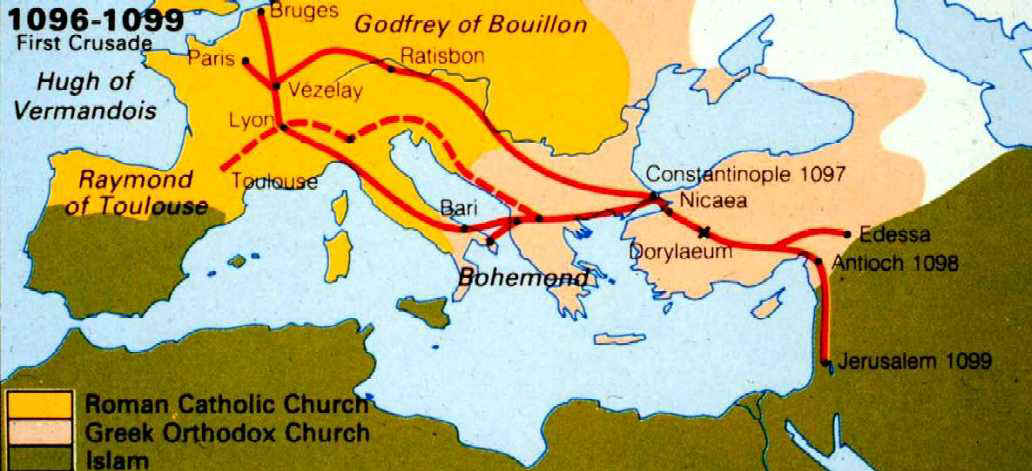
http://www.mmdtkw.org/CRUS0001-FirstCrusadeRouteMap.jpg
Getting there -- Wherever they started, and whether or not their route included a sea voyage, all the crusaders funneled through Constantinople. In that city the leaders were flattered and given gifts, and they and their armies were hustled through before they could do too much damage to the city. (They had already done enough damage before they got to Constantinople.) When in Constantinople the Crusades leaders promised to return to the Emperor cities and Byzantine territories that were recovered from the Turks. They may even have been sincere when they made their promises, but they found reasons not to honor their pledges.
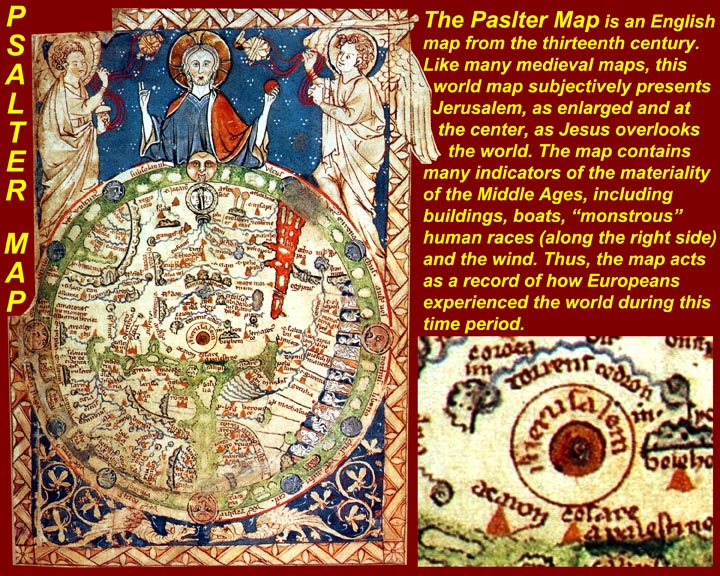
http://www.mmdtkw.org/CRUS0200-LondonPsalterMapSlide.jpg
Like most European late Medieval maps, the London Psalter Map places Jerusalem at the center of the earth. For more information, see http://www.bl.uk/onlinegallery/onlineex/mapsviews/psalter/.
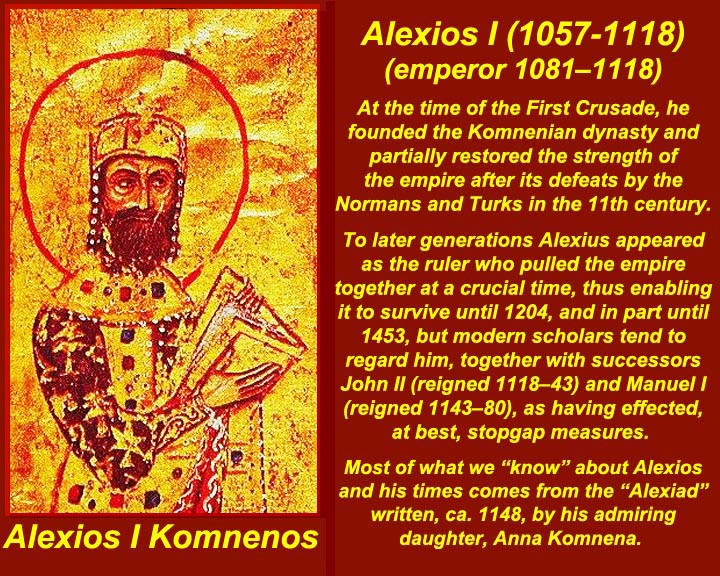
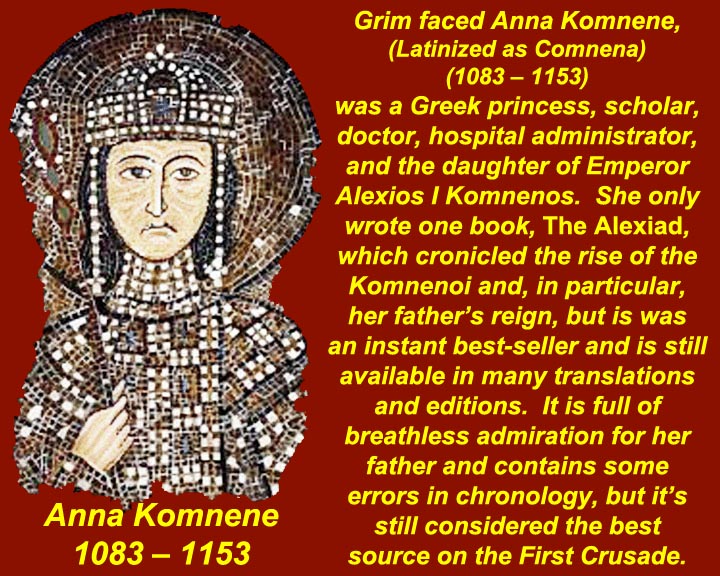
http://www.mmdtkw.org/CRUS0209-Alexios_I_Komnenos.jpg
http://www.mmdtkw.org/CRUS0210-AnnaKomnene.jpg
Alexios i Komnenos was the grandson of a previous Byzantine Emperor. His father had refused the succession and a member of another family was crowned. Alexios had a fine military career fighting Pechenegs, Normans, and Turks for the new Emperor, and eventually used his family and military connections to oust the Emperor and install himself. As Emperor, Alexios found himself gradually losing territory to the Seljuk Turks -- to the point that the Turks were posing a serious threat to his capital, Constantinople. The threat eventually got serious enough that he took the drastic step of asking the Pope of western Catholicism for help. For his own reasons, Pope Urban I responded affirmatively.
Anna Komnene was the very well educated and competent daughter of Emperor Alexios I. But she also had more than a touch of hero worship concerning members of the Komnenoi family and especially her father. Despite her clear exaggeration of his exploits and abilities and despite occasional errors in chronology her book, the Alexiad, written thirty years after the death of Alexios, is still the best available source of information about the Byzantine court, its allies, and its enemies. The book is also the first known history of any kind written by a woman.
For more information on Alexios I, see http://en.wikipedia.org/wiki/Alexios_I_Komnenos. For more information on Anna Komnena, see http://en.wikipedia.org/wiki/Anna_Komnene. For the entire text of the Alexiad in English translation, see http://www.fordham.edu/halsall/basis/AnnaComnena-Alexiad.asp.

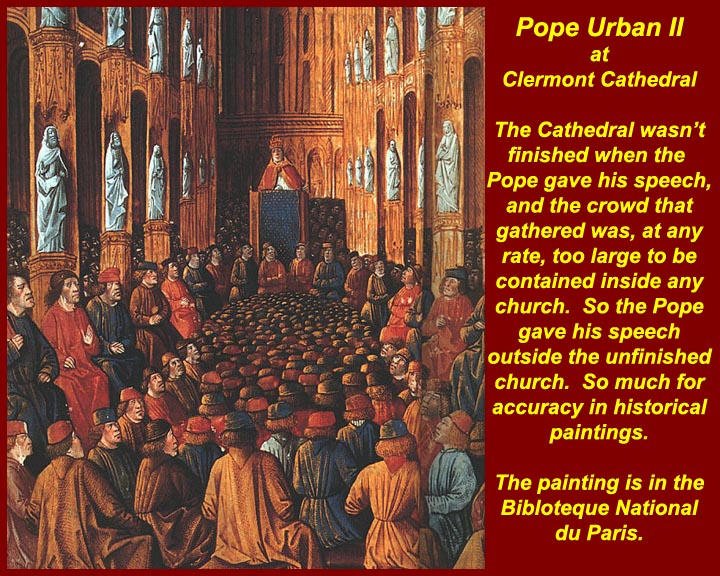
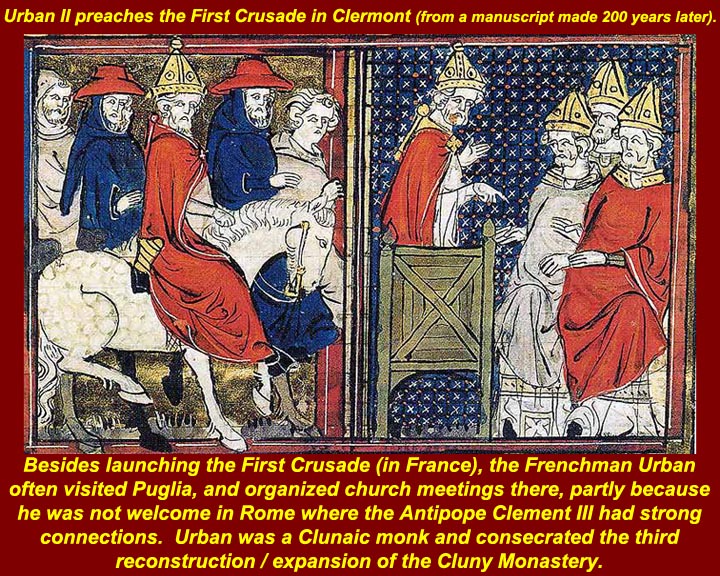
http://www.mmdtkw.org/CRUS0201-Urban1042-1099.jpg
http://www.mmdtkw.org/CRUS0202-UrbanSpeechCleremont.jpg
http://www.mmdtkw.org/CRUS0203-UrbanIIClermont.jpg
Pope Urban I responded positively to pleas for help from Alexios I Komnenos, the Byzantine Emperor. It's not ours to gainsay Urban's altruistic and religious motives, but it's also naive to think that he wouldn't know that he would benefit in prestige and power by being the person who got the First Crusade rolling.
For Information on Urban, see http://en.wikipedia.org/wiki/Pope_Urban_II
. For Urban's speech at Cleremont, see http://www.fordham.edu/halsall/source/urban2-fulcher.html.
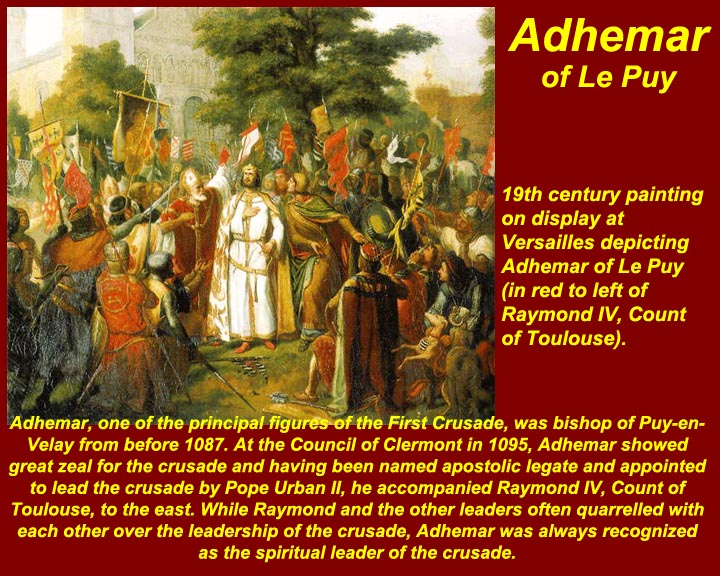
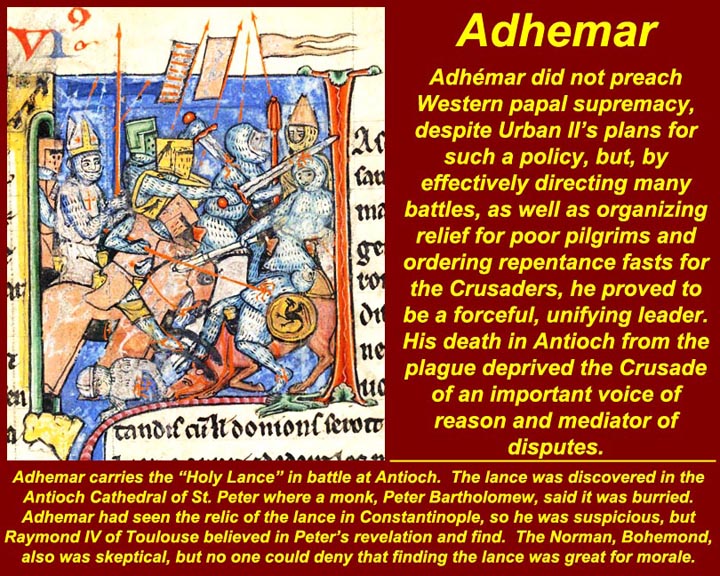
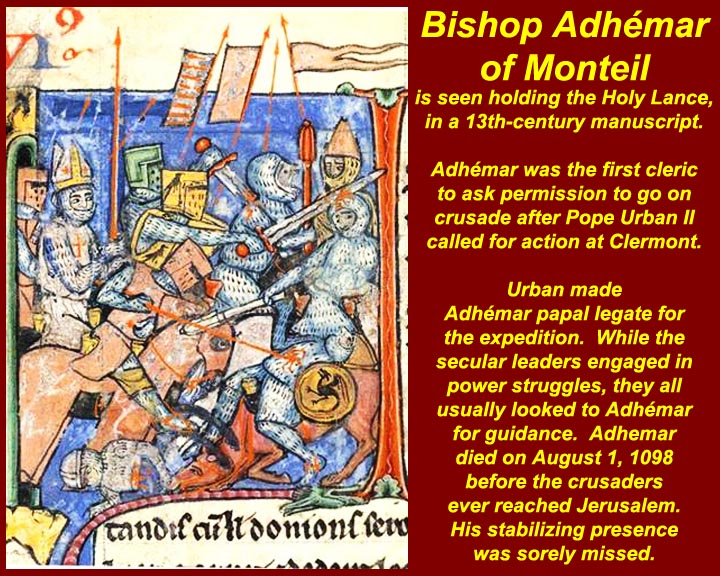
http://www.mmdtkw.org/CRUS0204-AdhemarDeLePuy.jpg
http://www.mmdtkw.org/CRUS0205-Adhemar.jpeg
http://www.mmdtkw.org/CRUS0206-Adhemar1087-1098.jpg
Adhemar was Bishop of Puy-en-Velay and, on hearing Urban's Clermont speech in 1095 he became an enthusiastic proselytizer of the idea of reconquering Jerusalem for Christianity. The Pope named Adhemar as his Legate -- i.e., put him in charge of the spiritual guidance of those who took the cross. By all accounts he was a great organizer both in the planning and carrying out of Crusade plans. His charismatic preaching is what really convinced Europeans to participate and his mediation abilities clearly kept the military leaders in harness -- that is demonstrated by what the disunity after his death (probably of typhus) on August 1, 1098. When he was gone, disputes among the higher nobles went unsolved, and the march to Jerusalem was delayed for months. The lower-class foot soldiers continued to think of dead Adhemar as a leader; some of them claimed to have been visited by his ghost during the siege of Jerusalem, and reported that Adhemar instructed them to hold another procession around the walls. When this was done, Jerusalem was taken by the Crusaders in 1099.
If you have access to the JSTOR database (which Encore Learning Members can arrange through George Mason U.) see the article at http://www.jstor.org/stable/2853164.
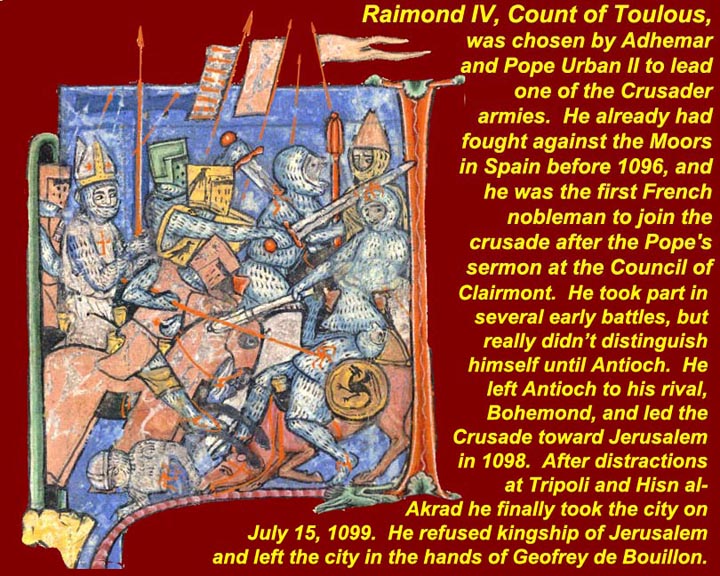
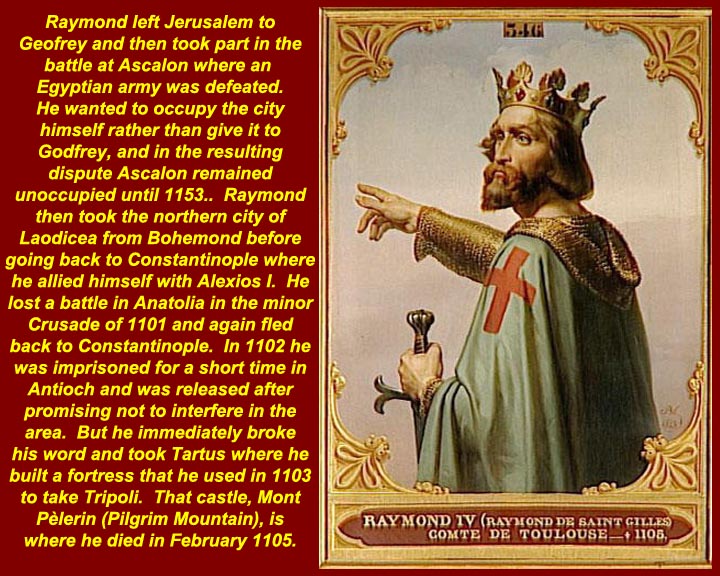
http://www.mmdtkw.org/CRUS0207-RaimondAdhemar.jpg
http://www.mmdtkw.org/CRUS0208-Raymond_IV_of_Toulouse.jpg
Raymond IV of Toulouse was chosen by Adhemar to be the military leader of the Crusade. He took part in several early confrontations with Muslim forces but did not distinguish himself until Antioch. He left Antioch to a rival, Bohemond, and led the march towar Jerusalem. After taking Jerusalem (with well known atrocities against the civilian population) he declined the kingship and left the city in the hands of Geofrey de Bouillon, who took the title "Princeps".
For more info on Raymond IV, see http://en.wikipedia.org/wiki/Raymond_IV,_Count_of_Toulouse.
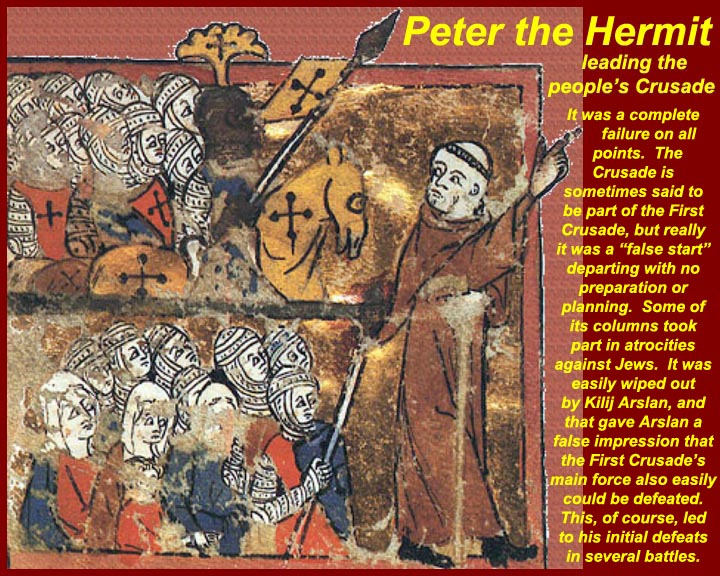
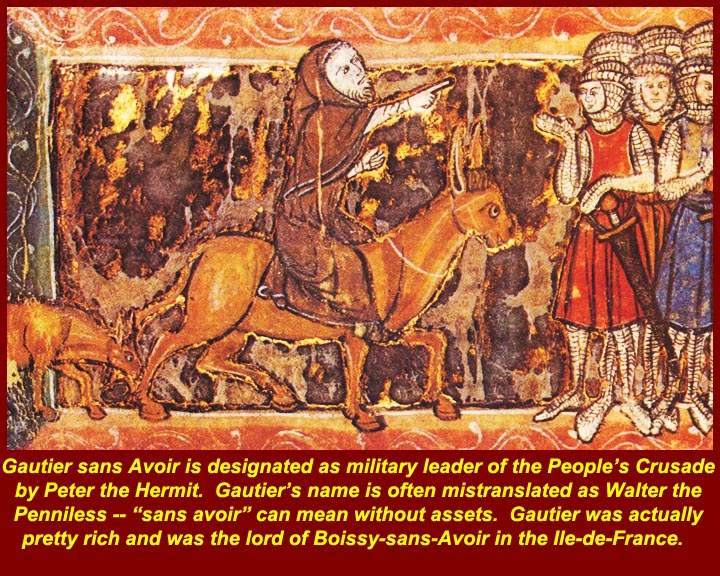
http://www.mmdtkw.org/CRUS0211-PeterHermit.jpg
http://www.mmdtkw.org/CRUS0212-PeterHermit-GautierSansAvoir.jpg
While Adhemar and Raymond were organizing the First Crusade, another unofficial "People's Crusade" made a premature start. It was led by another charismatic preacher, Peter the Hermit, and Peter's military appointee Gautier sans Avoir (incorrectly translated as Walter the Penniless). Some of the People's crusades committed atrocities against Jews in Europe even before crossing into Byzantine territory. The pogroms were condemned by the Pope and the "official" First Crusade leaders, but similar activities by members of later Crusades further blackened the reputation of the Crusades and the Church that sponsored them. Alexios expeditiously ushered the "People's Crusade" through Constantinople and into Khilij Arslan's Caliphate of Rum where Khilij easily massacred the whole operation. It was so easy, in fact, that Khilij got the false impression that the later and much better organized real First Crusade would also be easy pickings. That underestimation would later cost Khilij dearly.
Peter the Hermit is all over the Internet. (Enter "peter the hermit" -- with the quotation marks and lower case letters into your search engine unless you really want to know about Peter Noone of Herman's Hermits.) Contemporary descriptions of Peter the Hermit and his companions are available at http://www.fordham.edu/halsall/source/peterhermit.asp. Also see http://en.wikipedia.org/wiki/Peter_the_Hermit.
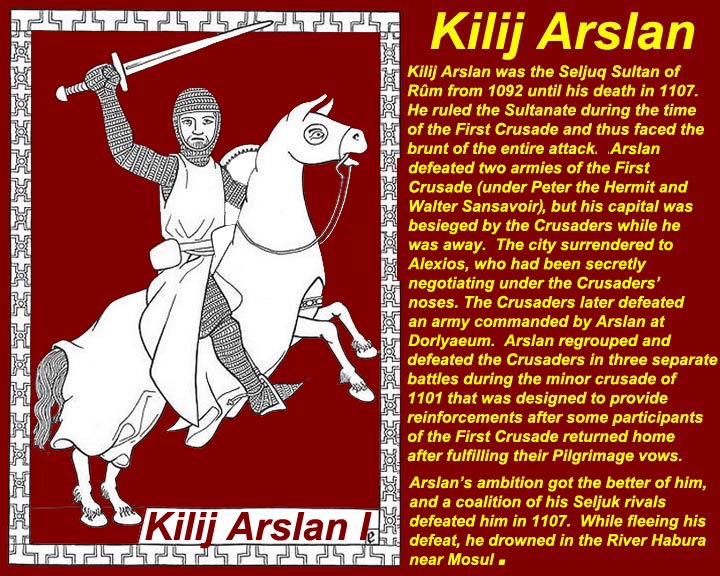
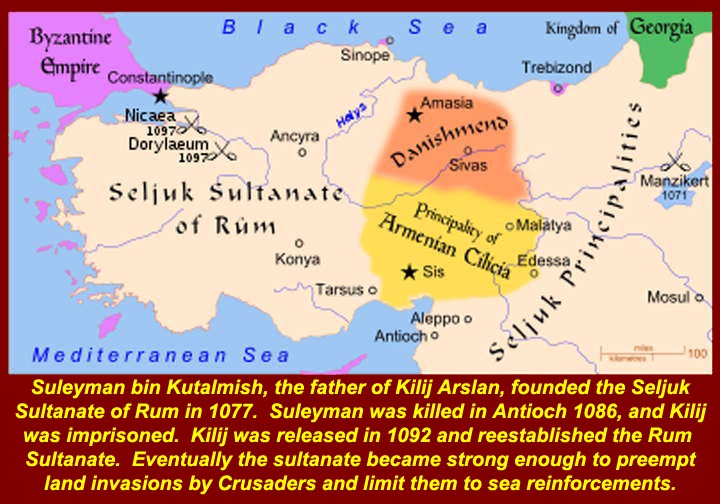
http://www.mmdtkw.org/CRUS0213-KilijArslan.jpg
http://www.mmdtkw.org/CRUS0214-KilijRum.jpg
Kilij Arslan I was the Sultan of Rum from 1092 until his death in 1107, and his territory included all the possible land routes for armies of the First Crusade. Kilij easily wiped out two columns of the People's Crusade (1096), which gave him a false sense of security. When the real First Crusade arrived Kilij lost his capita city Nicaea (he was away fighting Danishmends) and the crusader army also defeated him at Dorylaeum. Kilij was just a speed bump in the way of the First Crusade. He did, however, regoup and won three battles against reinforcement armies in a minor (i.e., unnumbered) crusade in 1101. Kilij died while trying to escape from a battle he lost against a Turkish rival in Syria in 1107.
For more information on Kilij I, see https://en.wikipedia.org/wiki/Kilij_Arslan_I.
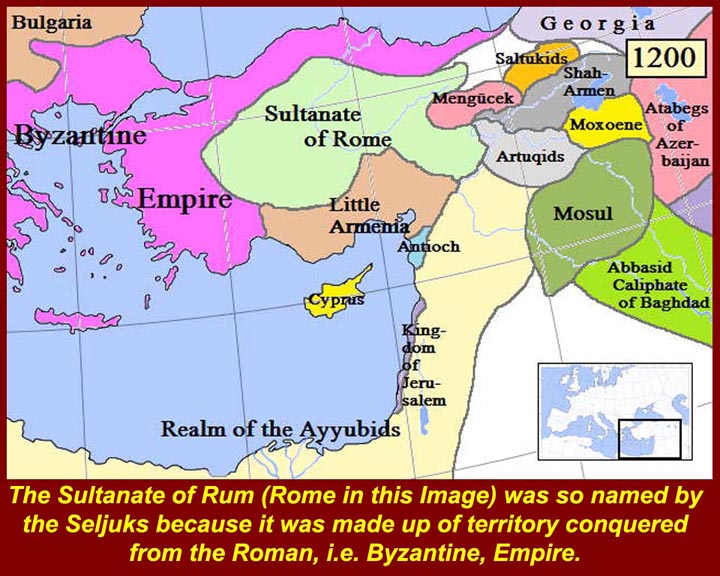
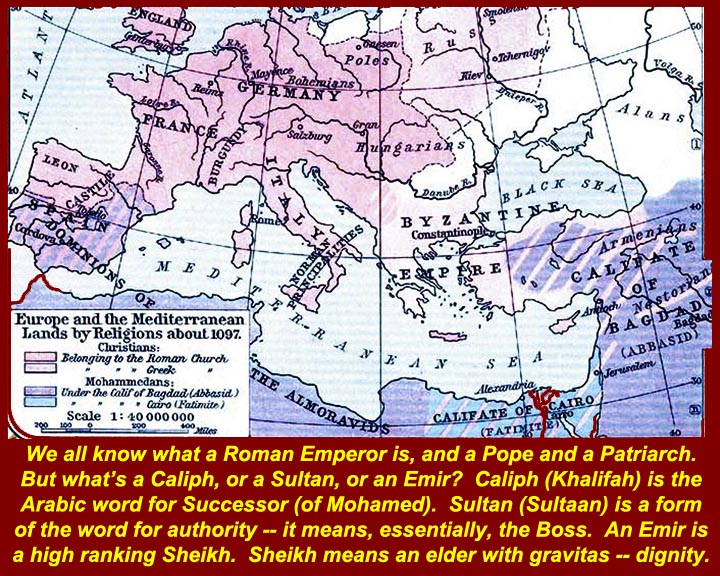
http://www.mmdtkw.org/CRUS0215-PostCrusade1Map1200.jpg
http://www.mmdtkw.org/CRUS0216-Byzantines-Caliphate.jpg
Two maps show who controlled what in the Middle East at the end of the First Crusade. The caption of the second map explains the meaning of the Arabic/Islamic titles: Caliph, Sultan, Emir, and Shaykh (Sheik).
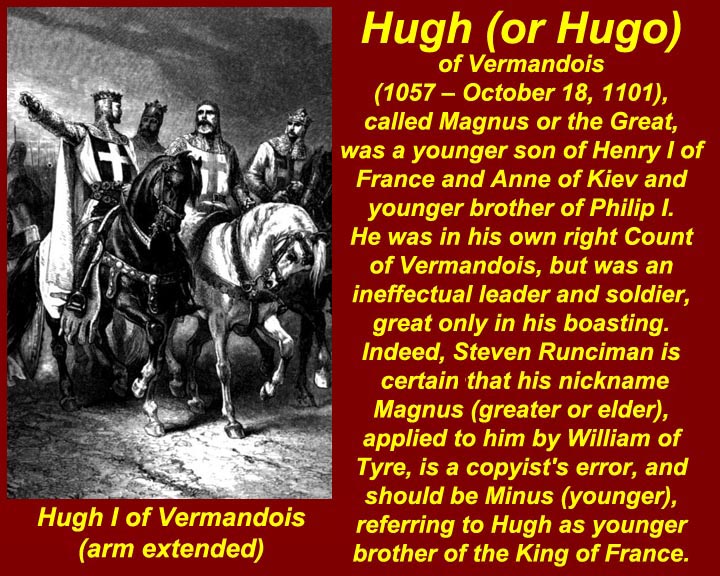
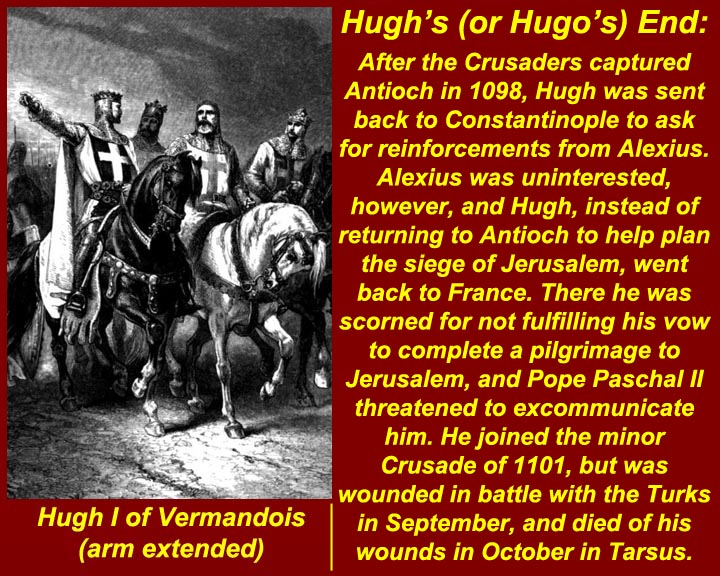
http://www.mmdtkw.org/CRUS0217-HughVermandois1057-1101-1.jpg
http://www.mmdtkw.org/CRUS0218-HughVermandois1057-1101-2.jpg
Not all of the crusaders were all that great -- even those called Magnus or le Grand, which mean "the Great". Hugues I 'le Grand' de Vermandois (Capet), Comte de Vermandois is the archetype of the not so great. Anna Komnena's description of him in the Alexiad (Book 10, Chapter 7 -- "Ubus") makes it clear that Hugh was a pompous ass.
Read about 'Ubus" (Hugh/Hugues) in the Alexiad at (http://www.fordham.edu/halsall/basis/AnnaComnena-Alexiad10.asp -- about half way down) or see http://en.wikipedia.org/wiki/Hugh_I,_Count_of_Vermandois.
Steven Runciman thought "Magnus" must have been a clerical error for "Minor", which would have meant he was the younger brother of King Phillip I Capet of France. The Magnus sobriquet might also have been applied in confusion with an earlier Hugues 'le Grand' de Paris (Capet), Comte de Paris who lived from 898 to 956.
Sir James Cochran Stevenson RUNCIMAN, CH, FBA (7 July 1903 – 1 November 2000) — known as Steven Runciman — was a British historian known for his work on the Middle Ages. His best known work is his three volume A History of the Crusades (1951-54).
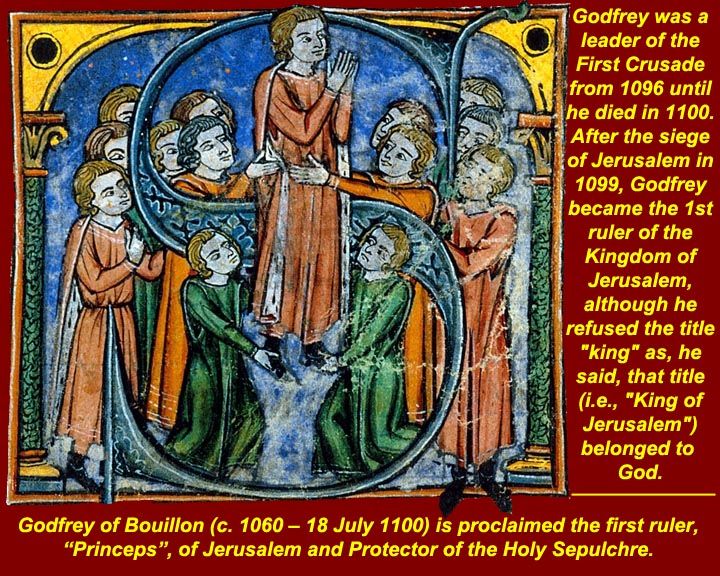
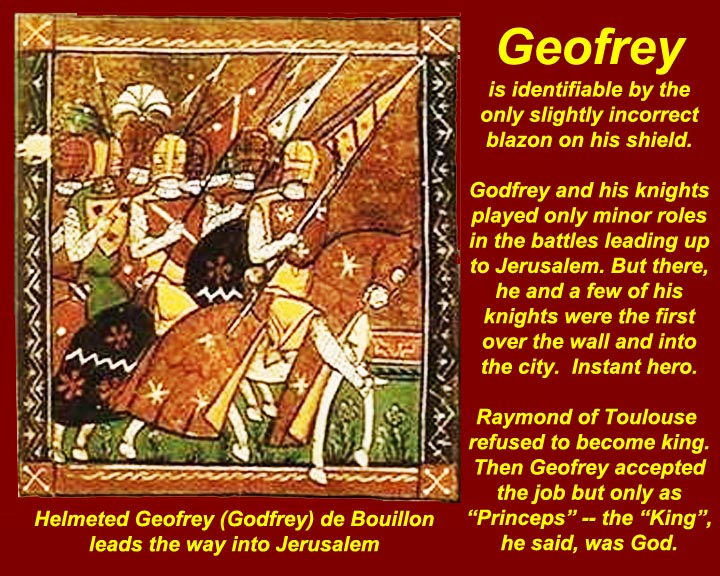
http://www.mmdtkw.org/CRUS0219-GodfreyDeBouillon.jpg
http://www.mmdtkw.org/CRUS0220-GeofreyDeBouillon1060-1100.jpg
Godfrey (or Geofrey) de Bouillon was the Duke of Lower Lorraine and had a les than distinguished crusader career until he and a few of his knights were the first over the wall in Jerusalem. When Raymond of Toulouse turned down the chance to be first ruler of the Kingdom of Jerusalem, the kingship was offered to Godfrey. Godfrey refused to be called King of "God's City", but he did accept the title of Princeps (usually translated as "first citizen" and from which comes the word "prince"), Duke, or Advocatus (Protector) of the Holy Sepulchre. Despite his own reticence, Godfrey is usually called the "First King of Jerusalem". Later rulers unabashedly called themselves Kings.
Whatever his title, Godfrey didn't hold it long:
"While he was besieging the city of Acre, Godfrey, the ruler of Jerusalem, was struck by an arrow, which killed him", reports the Arab chronicler Ibn al-Qalanisi. Christian chronicles make no mention of this; instead, Albert of Aix and Ekkehard of Aura report that Godfrey contracted an illness in Caesarea in June, 1100. It was later believed that the emir of Caesarea had poisoned him, but there seems to be no basis for this rumour; William of Tyre does not mention it. It is also said that he died after eating a poisoned apple. In any event, he died in Jerusalem after suffering from a prolonged illness.
From http://en.wikipedia.org/wiki/Godfrey_of_Bouillon
http://www.mmdtkw.org/CRUS0223-BohemondSiculoNormans.jpg
http://www.mmdtkw.org/CRUS0224-Bohemond_PatriarchDaimbert.jpg
http://www.mmdtkw.org/CRUS0225-BohemondFinale.jpg
http://www.mmdtkw.org/CRUS0226-BohemundSummingUp.jpg
http://www.mmdtkw.org/CRUS0227-BohemondAntioch.JPG
Most participants of the First Crusades had good motives. One of the few who were in it for themselves was, by all accounts, Bohemond. He rook Antioch for himself and barely lost out as he raced toward Jerusalem when Godfrey died. Unlike the braggart Hugues I 'le Grand', Bohemond successfully promoted himself as greatest of the crusaders. His story can be read in the captions of the seven images above or at http://en.wikipedia.org/wiki/Bohemond_I_of_Antioch.
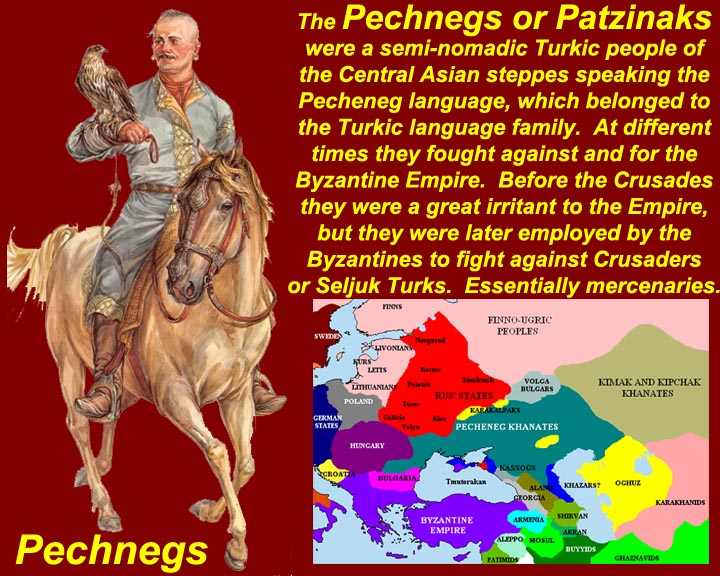
http://www.mmdtkw.org/CRUS0228a-Pecheneg.jpg
The Pechenegs were a subgroup of the Turkic people who spoke variants of the Oghuz Turkic language. All we really know about them is that they were an early (i.e.. pre-Crusade) irritant in the northern Byzantine border area. They were skilled mounted warriors who fought on their own behalf or, at various time fought for whoever would pay them the most. During the First Crusadeand succeeding crusades, they appeared as mercenaries on one or the other side (or both sides) of the battle lines.
See http://en.wikipedia.org/wiki/Pechenegs
Also see http://world.guns.ru/machine/rus/pecheneg-e.html for the equally dangerous post-Cold War Russian light machine gun.
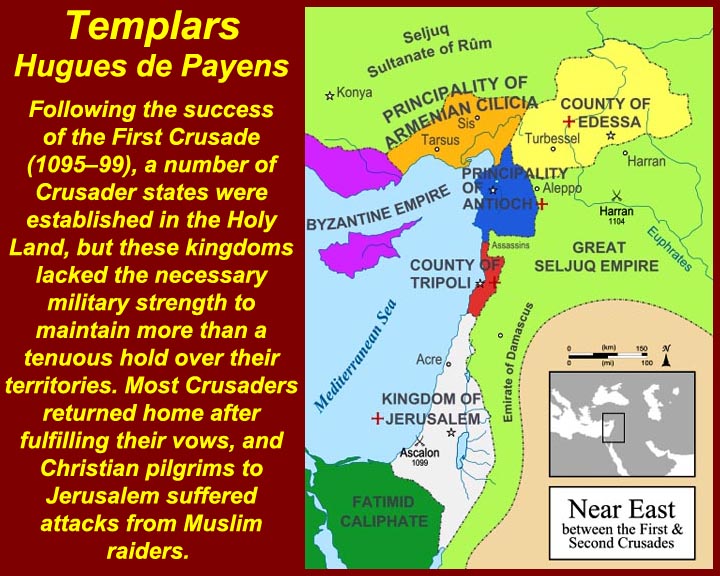
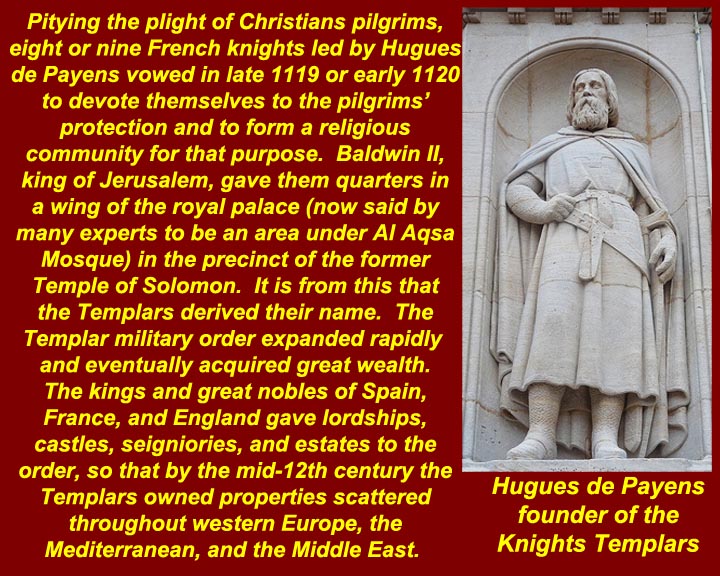
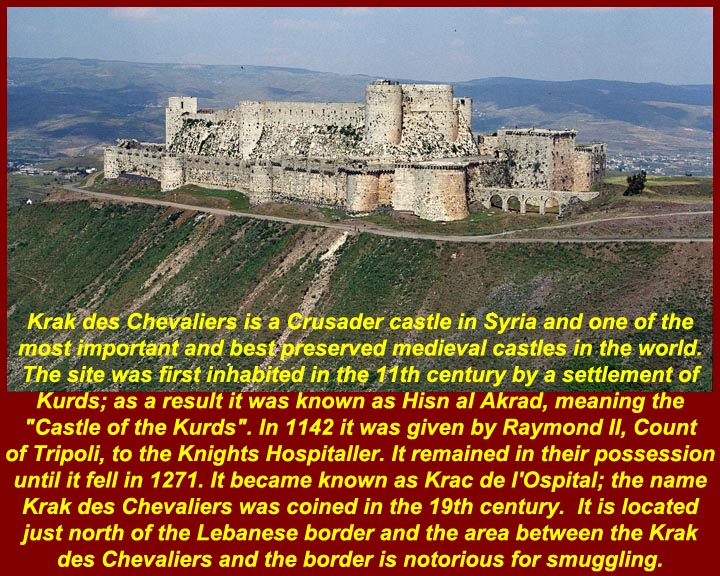
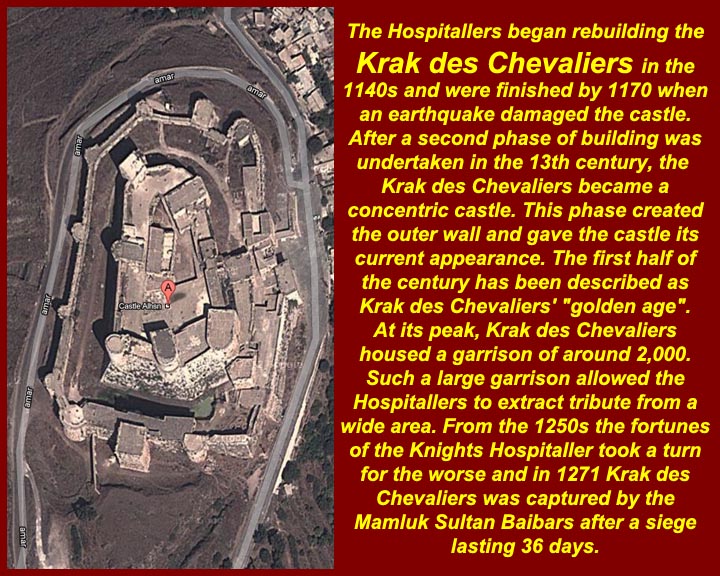
http://www.mmdtkw.org/CRUS0228b-HuguesDePayens-Templar.jpg
http://www.mmdtkw.org/CRUS0228c-HuguesDePayens-Templar1070-1136.jpg
http://www.mmdtkw.org/CRUS0228d-Krak_des_chevaliers1.jpg
http://www.mmdtkw.org/CRUS0228e-Krak_des_chevaliers2.jpg
Templars: After the First Crusade, the newly formed crusader states were barely able to hold their own core areas and definitely were not able to provide protection for Christian pilgrims in the Muslim controlled hinterland through which the pilgrims had to pass on their way to Jerusalem. In late 1119 or early 1120, a few French knights led by Hugues de Payens formed a military order to protect the travelers. Baldwin II, the King in Jerusalem billeted knights in a palace wing or outbuilding, which many experts now say was a space below the Al-Agsa Mosque, in the precinct of the former Temple of Solomon. It is from the Temple association that the Knights derived their name. The Knights Templar lasted for several centuries in the Middle East and reached their peak when their headquarters was in the Krak des Chevaliers, now in Syria just a few miles north of the Lebanese border. They were later suppressed and its Grand Master, Jaques Demolay was burned at the stake in 1314..
Masonic connections are unproven, and, in particular the Freemasonry Knights Templar acknowledge that all they take from the medieval order is their name and that "THERE IS NO PROOF OF DIRECT CONNECTION BETWEEN THE ANCIENT ORDER AND THE MODERN ORDER KNOWN TO DAY AS THE KNIGHTS TEMPLAR". (From http://www.knightstemplar.org/faq1.html#member -- scroll down.)
For information on the Templars, see http://www.newadvent.org/cathen/14493a.htm (for the Catholic side of the story) and http://en.wikipedia.org/wiki/Knights_Templar. The Wikipedia page is fairly straightforward, but follow-on links have some more esoteric versions. Reader beware: there's much misinformation about the Templars on the Internet; seing it on the net or on TV does not make it true.


